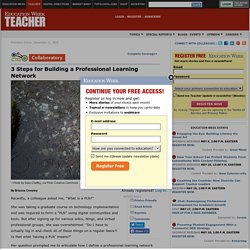

How Do I Get a PLN? What is a PLN? Will Richardson was the first person to clearly explain to me about six or seven years ago what a PLN was. Back then, PLN stood for Professional, or Personal Learning Network. A better label today, one that might quiet the nitpickers, is Personalized Learning Network -- the shift in nuance maintains that participants are both personal and professional learners. A PLN is a tool that uses social media and technology to collect, communicate, collaborate and create with connected colleagues anywhere at any time.
Participating educators, worldwide, make requests and share resources. Each individual educator becomes a potential source of information. PLNs Develop Thought Leaders Many early adopters of the PLN have gone on to become thought leaders in education, not surprising given that PLNs seem to promote a great deal of reflection and collaboration. Barriers to Mass Adoption We must remember that lifelong learning requires effort. PLNs Are Collaboration. Educational Leadership: Reflect, Refresh, Recharge: Create Your PLN: 6 Easy Steps.
3 Steps for Building a Professional Learning Network. Published Online: December 31, 2014 —Photo by Sean Chaffey, via Flickr Creative Commons By Brianna Crowley Recently, a colleague asked me, “What is a PLN?”

She was taking a graduate course on technology implementation and was required to form a “PLN” using digital communities and tools. But after signing up for various wikis, Nings, and virtual professional groups, she was overwhelmed: “Do I have to actually log in and check all of these things on a regular basis?! Her question prompted me to articulate how I define a professional learning network (PLN) and how I have shaped my own. 20 Tips for Creating a Professional Learning Network. Personal Learning Networks for Educators: 10 Tips. By Dr.

Mark Wagner I often begin my workshop on personal learning networks (PLN) for educators by asking these questions: Who is in your learning network? Who do you learn from on a regular basis? Who do you turn to for your own professional development? Some educators are lucky enough to learn from their coworkers or colleagues at their site. PLN: Your Personal Learning Network Made Easy. What is a PLN?

If I had to define what a ‘Personal Learning Network’ is, I would keep it simple and broad: n. – the entire collection of people with whom you engage and exchange information, usually online. Personal Learning Networks, or PLNs, have been around forever. Originally, they were your family and friends, maybe other educators you worked with, but as the internet and web 2.0 tools have become nearly ubiquitous, PLNs can include tons of different communities – social networking sites like Facebook, blogs, Twitter, wikis, social bookmarking tools, LinkedIn, and so many more. Basically, anyone that you interact with is apart of your PLN, whether they are social contacts, professional peers, or experts in their field. PLNs have immense value! So, why bother thinking about your PLN? Students can also reap the benefits of tapping into their PLNs. Build Your Own PLN If you’re interested in expanding your PLN, here’s a directory of some of the best web 2.0 tools: Like this: Like Loading...
Blogs: An Important Part of Your PLN. About ETR Community EdTechReview (ETR) is a community of and for everyone involved in education technology to connect and collaborate both online and offline to discover, learn, utilize and share about the best ways technology can improve learning, teaching, and leading in the 21st century.

EdTechReview spreads awareness on education technology and its role in 21st century education through best research and practices of using technology in education, and by facilitating events, training, professional development, and consultation in its adoption and implementation. What Everyone Should Know About RSS Feeds. Perhaps you've seen text or image buttons on various websites inviting you to "subscribe via RSS.

" Well, what does that mean exactly? What is RSS, what are RSS feeds, and how do you get them to work for you? Short for Really Simple Syndication or Rich Site Summary, RSS revolutionized the way that users interact with content online. Instead of checking back every day to any particular site to see if it's been updated, RSS feeds give users the ability to simply subscribe to the RSS feed, much like you would subscribe to a newspaper, and then read the updates from the site, delivered via RSS feeds, in what's called a "feed reader.
" RSS feeds benefit those who actually own or publish a website as well since site owners can get their updated content to subscribers much more quickly by submitting feeds to various XML and RSS directories. How Do RSS Feeds Work? This content can be aggregated to be viewed even more easily by using a feed reader.